

Image via Pixabay. Pixabay License.
Pixabay
Both Trump and Biden want tariffs. But here is a better way to boost the economy.President Biden has called for increasing tariffs on imports of steel from China. President Trump has also called for increasing tariffs on all goods from China. Although these tariffs may help with shifting some demand to United States steel, there is a cost involved to the consumer: inflation. The economy was strong during the Trump administration, but Forbes analyzed the effect of tariffs during that time. The conclusion was mixed, but the tariffs may not have been as positive as originally believed.
Most economists agree that tariffs don’t always produce a boost in U.S. manufacturing. In addition, the cost of goods to consumers usually increases, while at the same time, there could be no significant creation of jobs. Experts point out that there could be a host of cost increases to more than just steel, including the price of electric vehicles, solar cells, batteries, battery materials, cranes used at ports, and certain medical supplies.
A better alternative to tariffs would be a modification of the Investment Tax Credit (ITC).
The origin of the Investment Tax Credit
Much is made of President John F. Kennedy’s tax cuts and the improved economy that followed. Yes, Kennedy lowered the tax brackets, dropping the top rates for individuals from 90 down to 70 percent, and corporate rates were lowered only to 48 percent from 52. What is lost in the discussion is the real stimulus that affected the growth of the economy of the 1960s.
President Kennedy noticed that the Japanese economy rebounded from the effects of World War Two at a very quick pace. He investigated and concluded that the Investment Tax Credit (ITC) was the reason for the Japanese recovery. The Kennedy tax reform not only cut the tax rates; he gave an added incentive for investment in new equipment. This resulted in an increase in investment and, as a result, increased productivity and a much improved economy.
What was the Investment Tax Credit?
The ITC was a credit given to investors (businesses) for purchases of tangible property. The property had to be personal property (IRS §1245) as opposed to real property (IRS §1250). Real property is real estate and land. Personal property is equipment that is movable and not part of a fixture to real property.
The ITC was a credit from taxes. That is, it was not a deduction from income, but a direct credit. This deduction was also exclusive of depreciation allowances. In other words, it did not affect the book or tax value of the property. Depreciation was still calculated on the cost basis of the asset.
A Look at the ITC and its effect on the Steel Industry
President Biden has expressed his desire to place tariffs on China and more explicitly China steel imports. An example of what effect the ITC had on the economy of the United States can be found in examining the steel industry.
The Revenue Act of 1962 consisted of two items. It introduced the Investment Tax Credit and required the reporting to the government of interest and dividend payments. The ITC was set at the rate of seven percent. This was enacted to encourage business investment in equipment.
The Revenue Act of 1964 was enacted mainly to reduce the impact of taxes on the economy of the country. It provided the largest individual and corporate rate reduction since the original act of 1913. Among the changes made was that it increased the Investment Tax Credit to 10 percent.
The Tax Reform Act of 1969 represented a substantive and comprehensive reform of the income tax laws. It basically increased taxes and drastically cut back the depreciation allowances on commercial and industrial buildings. Most importantly, the act also repealed the Investment Tax Credit.
The Revenue Act of 1971 introduced a variety of tax incentives, including restoring the Investment Tax Credit.
The Tax Reduction Act of 1975 reduced both individual and corporate taxes. The Investment Tax Credit was increased in this act and was expanded to include more assets eligible for the credit.
In my senior year of studying accounting and finance, I was required to analyze the U.S. steel industry. I discovered a strong correlation between the Investment Tax Credit and investment in the steel industry.
- The Revenue Act of 1964 with its Investment Tax Credit resulted in an increase of capital expenditures of 51.74% over the average of the period 1958–1963. This figure continued to increase by an average rate of 7.2% until 1970 when capital expenditures decreased by 15.4%. This was the year the ITC was repealed.
- During the same period (1964 – 1970) return on assets and return on investment remained constant. Then in 1970 return on assets dropped by 45.0% and return on investment dropped by 71.7%. This coincides with the Tax Reform Act of 1969 and the repeal of ITC.
- Capital expenditures declined again in 1971 and 1972 and rose only slightly despite the reinstating of the ITC in 1971. Return on assets dropped to its lowest point ever in the years 1970 and 1971 with figures of 0.028 and 0.024, respectively. Return on investment also dropped to its lowest point with figures of 0.153 in 1970 and 0.216 in 1971.
- The ITC increase in 1975 resulted in an increase in capital expenditures of 151.65% over 1973.
President Kennedy’s assumption that Japan’s economy rebounded so quickly after World War Two due to the Investment Tax Credit could be supported by the fact that beginning in the early 1950s, trends in U.S. steel production diverged markedly from those of Japan. From 1950 to 1970, production of steel by U.S. firms increased at an average rate of 1.5 percent a year compared with average increases of 16 percent in Japan. The U.S. Steel industry has been playing catch-up since the 1950s.
The Effect of the Investment Tax Credit on the U.S. Economy
Similar correlations to those of the U.S. steel industry could be made with the overall U.S. economy and the Gross Domestic Product. When the ITC was implemented in the 1960s, there was an immediate effect on the economy of the United States. There is a highly positive correlation between the ITC and economic growth throughout the lifetime of the ITC.
The ITC was implemented with The Revenue Act of 1962. It was effective for tax years beginning after December 31, 1961. It applied to property purchased in 1962. The increase in GDP in 1962 was 6.1%. It continued to grow at increasing rates until 1970.
The Tax Reform Act of 1969’s most significant addition to the tax law was the Alternative Minimum Tax on high-income taxpayers. The most significant change to corporations and small business owners was that it repealed the Investment Tax Credit.
Coincidentally, The GDP decreased for the first time in 1970 since the recession, which ended in 1957. From 1962 until 1969, during the life of the ITC, the GDP grew an average of 5 percent per year.
In 1986, President Reagan signed into law the Tax Reform Act; in it was the elimination of the Investment Tax Credit. In 1987, the stock market crashed and suffered its biggest loss since the stock market crash of 1929. A recession followed.
During times when the ITC was repealed, a significant reduction in economic growth and activity followed. Conversely, when the ITC would be reinstated, or increased, the effect was an immediate and significant positive effect on the economy.
The America First Tax Credit
The better option for stimulating the economy is using a carrot rather than a stick. Investment should be encouraged rather than adding an extra cost in the form of tariffs, which is passed on to the consumer. A modified Investment Tax Credit should be implemented.
A credit called the America First Tax Credit (AFTC) should be used. A tax credit should be created for investment in personal property (IRS §1245) produced in the United States. This will encourage investment in “Made in the USA” goods and investment in America without the effect of the inflation associated with tariffs.
I believe that it is time for Congress to give serious consideration to restoring a tax provision that has a proven track record.
David Ennocenti is a retired accountant and a graduate of the State University of N.Y. at Buffalo, School of Management with a degree in accounting and finance. He passed the CPA Examination in 1983. His writing has appeared in The American Thinker, USA Today, The New York Times, and several other publications. His screenplay, “Sniper Queen,” was an official selection of the Artemis Women in Action Films Festival. He is a past winner of the Writer’s Digest Annual Competition. His essay “1984 Arrived: Now What? How Progressive Policies Decimated a Once Vibrant Community” is available on Amazon.
<img a alt="
Image via <a data-cke-saved-href=" captext="




